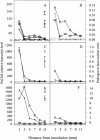Temporal and spatial profiles of chitinase expression by norway spruce in response to bark colonization by Heterobasidion annosum
- PMID: 15240268
- PMCID: PMC444825
- DOI: 10.1128/AEM.70.7.3948-3953.2004
Temporal and spatial profiles of chitinase expression by norway spruce in response to bark colonization by Heterobasidion annosum
Abstract
Pathogen colonization and transcript levels of three host chitinases, putatively representing classes I, II, and IV, were monitored with real-time PCR after wounding and bark infection by Heterobasidion annosum in 32-year-old trees of Norway spruce (Picea abies) with low (clone 409) or high (clone 589) resistance to this pathogen. Three days after inoculation, comparable colonization levels were observed in both clones in the area immediately adjacent to inoculation. At 14 days after infection, pathogen colonization was restricted to the area immediately adjacent to the site of inoculation for clone 589 but had progressed further into the host tissue in clone 409. Transcript levels of the class II and IV chitinases increased after wounding or inoculation, but the transcript level of the class I chitinase declined after these treatments. Transcript levels of the class II and class IV chitinases were higher in areas immediately adjacent to the inoculation site in clone 589 than in similar sites in clone 409 3 days after inoculation. This difference was even more pronounced 2 to 6 mm away from the inoculation point, where no infection was yet established, and suggests that the clones differ in the rate of chitinase-related signal perception or transduction. At 14 days after inoculation, these transcript levels were higher in clone 409 than in clone 589, suggesting that the massive upregulation of class II and IV chitinases after the establishment of infection comes too late to reduce or prevent pathogen colonization.
Figures


References
-
- Altschul, S. F., W. Gish, W. Miller, E. W. Myers, and D. J. Lipman. 1990. Basic local alignment search tool. J. Mol. Biol. 215:403-410. - PubMed
-
- Barber, M. S., R. E. Bertram, and J. P. Ride. 1989. Chitin oligosaccharides elicit lignification in wounded wheat leaves. Physiol. Mol. Plant Pathol. 34:3-12.
-
- Biswas, M., J. F. O'Rourke, E. Camon, G. Fraser, A. Kanapin, Y. Karavidopoulou, P. Kersey, E. Kriventseva, V. Mittard, N. Mulder, I. Phan, F. Servant, and R. Apweiler. 2002. Applications of InterPro in protein annotation and genome analysis. Brief Bioinform. 3:285-295. - PubMed
-
- Broglie, K., I. Chet, M. Holliday, R. Cressman, P. Biddle, S. Knowlton, C. J. Mauvais, and R. Broglie. 1991. Transgenic plants with enhanced resistance to the fungal pathogen Rhizoctonia solani. Science 254:1194-1197. - PubMed
-
- Brunner, F., A. Stintzi, B. Fritig, and M. Legrand. 1998. Substrate specificities of tobacco chitinases. Plant J. 14:225-234. - PubMed
Publication types
MeSH terms
Substances
LinkOut - more resources
Full Text Sources

